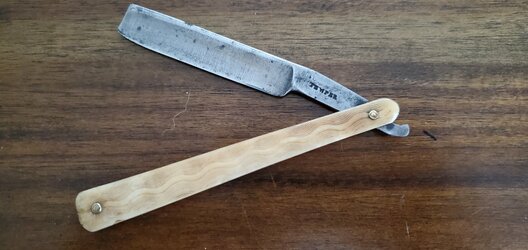We don't discuss this much. Obviously some razors have weird geometry issues, most which can be fixed. Some razors smile, some frown, and both can be salvageable depending on how much steel is left. Lots of guys willmcut a razor down that has a chip in the end. So I know there are a number of us willing to accept a less-than-perfect razor. That said, most people here at least alter out the flaw as best as possible.
I have am very old razor I picked up off ebay a year or so ago. I paid less than $100 for it (actually more like half that), so I don't think anyone will argue I got gyped. But I want to shave with it. Try as I may, the shaves are... well not that good. I can get it to take an edge. It will scrape hair (not an incorrect description there) off my face without ritual bloodletting. If I use care, it's not even terribly harsh. But it is harsh, and the shave is right around socially acceptable (military version) and that's about it. After study with the loupe, I have found there are sections on the blade that almost look like pitting on the bevel. I mark them, hone them out, and find that there are pitted sections that weren't there before aftermarket hone. Not much I cam do with that, I chalk it up to alloy/heat treat/tempering.
But it will remain, and I will shave with it on occasion. It's a 200 year old razor by my guess (quite possibly older, but I doubt by much). I could get aggressive with honing and remove more metal to see if I run into good steel, but I'm not willing to do that with a razor this age. I didn't even want to clean it up any when I got it, but I did carefully remove the blade from scales and clean some pretty nasty rust at the pivot pin, along with a few spots elsewhere. Other than that it is as I received it.
So, do you abide flawed razors? None at all? Maybe a couple of very old ones? Or all the time? A picture of the offender:

I have am very old razor I picked up off ebay a year or so ago. I paid less than $100 for it (actually more like half that), so I don't think anyone will argue I got gyped. But I want to shave with it. Try as I may, the shaves are... well not that good. I can get it to take an edge. It will scrape hair (not an incorrect description there) off my face without ritual bloodletting. If I use care, it's not even terribly harsh. But it is harsh, and the shave is right around socially acceptable (military version) and that's about it. After study with the loupe, I have found there are sections on the blade that almost look like pitting on the bevel. I mark them, hone them out, and find that there are pitted sections that weren't there before aftermarket hone. Not much I cam do with that, I chalk it up to alloy/heat treat/tempering.
But it will remain, and I will shave with it on occasion. It's a 200 year old razor by my guess (quite possibly older, but I doubt by much). I could get aggressive with honing and remove more metal to see if I run into good steel, but I'm not willing to do that with a razor this age. I didn't even want to clean it up any when I got it, but I did carefully remove the blade from scales and clean some pretty nasty rust at the pivot pin, along with a few spots elsewhere. Other than that it is as I received it.
So, do you abide flawed razors? None at all? Maybe a couple of very old ones? Or all the time? A picture of the offender:




